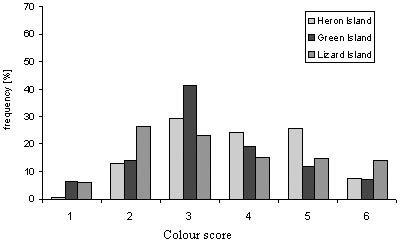VELS - Allowing marine studies to come to life
What I learned at the courses of 2005
New Ripples This system is much easier for beginners and when time is short, either to train students or when you have limited time at a reef. The program comes with a results spread sheet that can give students instant feedback to whether the reef they have looked at is healthy or not.
A healthy reef would be expected to have a majority of corals with scores over 3, a few corals with scores of 2 and a very small number of corals with a colour score of 1. The distribution graph would be similar to the graph below.
| 
Coral Health Chart surveys on Heron, Green
and Lizard Island during July 2002 |